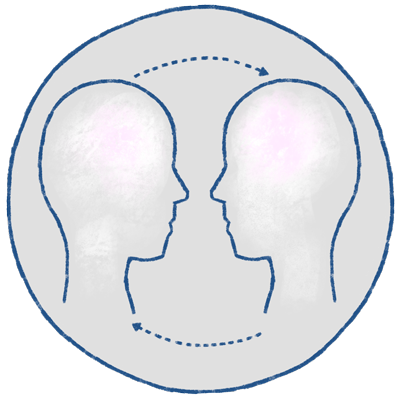I previously worked as a research scientist and consultant on a well-known emotional intelligence (EQ) assessment. I also developed training programs and coached leaders to improve their emotional intelligence and communication skills. During that time, I conducted emotional intelligence assessment debriefs with leaders at a manufacturing company. There, I met Julie, a manager with a reputation for being a reliable contributor, who expressed her frustration with her new boss, Amy. Despite her seniority, Amy was completing work that should have been delegated to Julie–and making mistakes because she didn’t consult her. Julie wondered why her boss didn’t trust her and what she was doing wrong.
I also met and completed an assessment with Amy. During our conversation, Amy revealed that she had been under tremendous stress since starting her new role. She felt pressure to perform well at work while her partner dealt with a serious health issue, leaving her solely responsible for their home. Amy acknowledged that there were likely many areas she could improve, including workplace communication, but she was just trying to survive.
What is emotionally intelligent communication?
Emotional intelligence is the ability to understand your own emotions and the emotions of others so that you can live your intentions. EQ helps leaders achieve their desired impact through communication by creating an awareness of emotional dynamics and helping them use that information to adapt to the situation and express themselves impactfully.
No matter the goal of your communication, EQ is critical. Whether you’re creating alignment around a strategic direction or settling a dispute between team members, leaders need to inspire action, influence opinions, validate emotions, and open hearts and minds. As told in the story above, a lack of social awareness can send the wrong message and erode the confidence of capable, committed team members.
How does emotional intelligence in communication impact teams?
Teams are greater than the sum of their parts. They can achieve more together than they could individually. The power of the collective efforts of organizations exists because of people and the forces that either empower them to do more together or come between and pull them apart. I believe that the catalyst of an organization’s power is trust, and it’s a leader’s job to cultivate it.
I think of trust as the oil that greases the gears of your team and organization. Consider a leader communicating their vision for change. There will always be team members who disagree with the approach. But what these employees do depends on a leader’s ability to build trust with emotional intelligence.
What might employees do in a low-trust organization? They might resist, protect their own interests, or become disengaged. Successfully leading this change will feel like climbing a mountain. Change will happen slowly, or, more likely, it won’t happen at all.
But what if your organization is trust-rich? Employees may still disagree with your approach, perhaps justifiably. But if they trust that the leader understands and believe that the leader has and will continue to consider their interests and concerns, team members are more likely to be committed and energized. And they’ll do so despite objections, while being eager to learn and contribute. Change will be smoother as employees commit to and engage with a shared vision.
This quality of trust-rich organizations is why so many companies have increasingly focused attention on emotional intelligence. EQ plays a key role in developing values such as inclusivity, mutual respect, collaboration, and teamwork, and in helping companies achieve their mission and purpose.
How can leaders use emotional intelligence to improve communication?
While emotional intelligence and communication are critical skills for everyone to work on, they’re especially important for leaders. A leader’s communication can have positive or negative effects that ripple far and wide. They face high expectations and pressures that affect themselves and their teams. And they often need to communicate in different ways with different team members, requiring emotional awareness and flexibility.
My experience with Amy, the boss who didn’t delegate, and Julie, the team member who wondered where she’d failed, isn’t uncommon. Their opportunities for development apply to many leaders looking to build their skills in emotionally intelligent communication. Here are some ways leaders can use emotional intelligence to improve communication:

1. Develop your ability to operate under stress.
How can you combat the negative effects of stress? Research demonstrates that emotionally intelligent people tend to be better able to manage stress. High EQ can help you handle issues that cause stress by enabling you to speak up for yourself, communicate your needs, stay focused on goals, and collaborate with others effectively. Beyond that, high EQ helps people adapt to change, maintain a positive outlook, and stay calm in the face of challenges.
If you struggle to manage stress, it can inhibit your ability to demonstrate emotional intelligence. Under stress, you are likely to focus on direct actions that reduce perceived threats. These actions that occur under stress can send the wrong message to others and create additional long-term problems that cause even more stress.
So, for Amy, and leaders like her, better stress management is the first step. I suggest doing these things:
- Know your physiological, behavioral, and emotional reaction to stress. How does your communication and decision making change because of stress? Start to learn the patterns.
- Practice one or two go-to stress management techniques that you can use when you’re under stress to access a calm, reflective state.

2. Demonstrate empathy.
When people talk about empathy, they might be referring to a few different qualities that are important for emotionally intelligent communication:
- Valuing others’ feelings.
- Reading and understanding others’ emotions.
- Making others feel validated and understood.
Empathy is needed to build trust in any relationship. Whether someone values others’ feelings roughly equates to whether they value meaningful relationships.
Many leaders find it difficult to make time and effort to consider others’ emotions, especially when they’re under pressure themselves. Hey, nobody asks how they’re doing!
Another potential challenge is that many people can’t accurately identify emotions from body language and verbal cues alone.
I discovered this challenge about myself as I worked on and took numerous emotional intelligence and communication assessments. In this area, it made more sense to lean into my strength rather than try to improve my intuitions. I developed a habit of asking directly, “how does that make you feel?” I find that this approach helps me make sense of emotional dynamics that I may not have appreciated, and also demonstrates an honest desire to understand the other person and build trust.
There’s science that supports this approach. In 2021, researchers from Stanford and Harvard investigated the relationship between trust and acknowledging others' emotions. They found that people in the workplace perceive showing and recognizing emotions as risky--and potentially costly--behavior. A willingness to be emotionally vulnerable makes interactions more meaningful, building trust.
The research also showed that acknowledging negative emotions builds greater trust than acknowledging positive emotions. Perhaps more importantly, you don’t have to be perfect. Even if you misidentify someone’s emotions, you’ll build trust just because you made the effort.
You might think that it's risky to acknowledge emotions in a professional setting, but that's exactly why you should do it. It’s the best way to communicate effectively and build trust.

3. Practice vulnerability.
It can be scary to show a part of yourself that's imperfect. And the more senior you are, the more pressure there tends to be to present a flawless exterior. Many leaders, perhaps Amy included, maintain the mask of perfection and competency out of fear that being vulnerable will cause others to lose trust in them.
But that is exactly why vulnerability builds trust. You share something about yourself that you wouldn't show to just anyone. And you set a positive example. When people see that showing emotion is OK, a culture of openness can start to form.
Our research of over 13,000 leaders around the world confirms the importance of vulnerability. When leaders regularly display vulnerability, their employees are 5.3X more likely to trust them. Furthermore, when leaders genuinely acknowledge their failures or shortcomings, they were 7.5X more likely to maintain trust over those that did not.
The overwhelmed boss, Amy, could have asked Julie for input on the parts of her role that she was unfamiliar with. Showing vulnerability could have built trust between the two while relieving Amy of some of the stressful work that she failed to delegate on her own.
The Importance of Emotional Intelligence in the Workplace
Emotional intelligence leverages awareness, emotional control, and honesty to enable effective communication skills that inspire trust and build meaningful, strong relationships. And while EQ can be developed with some intention and practice, it starts with building awareness, which doesn’t always come naturally.
Objective validated assessments of emotional intelligence, especially behavioral, simulation-based assessments like DDI’s Manager Ready, can provide a snapshot of key areas that could be improved or leveraged in communication and relationship building.
But the real impact of an assessment comes when a person uses their results to identify patterns in their behavior and the impact it has on their life. It's those “lightbulb moments” when data becomes insight: "Oh, that's why I made that decision" or "that's why my presentation didn't land with that audience."
The benefit comes when those insights lead to commitment to action and improvement. And that’s why assessments should be accompanied by coaching or training. People need support to contextualize results and seize the moment of inspiration to grow.
All this to say, as you consider how to teach emotional intelligence and communication in the workplace, be sure to incorporate opportunities for focused reflection, sensemaking, and supported development.
Want to learn more about emotional intelligence in the workplace? Read our blog: How Leading with Emotional Intelligence Drives Engagement.
Michael Vodianoi is a Leadership Strategist at DDI. When he isn't helping his clients solve their biggest people challenges, you might find him singing and dancing with his kids.
Topics covered in this blog

